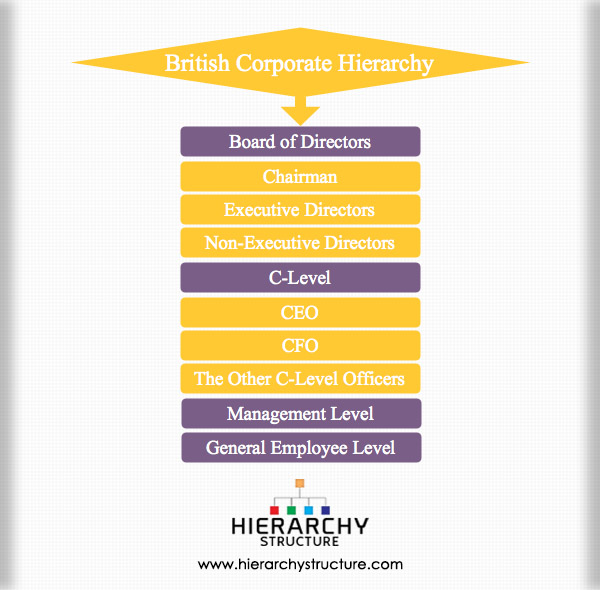A British organization comprises of many persons having different job titles, job responsibilities, and different levels of power in the corporation but working all together for the success of their business. British Corporate hierarchy is composed of different levels depending on the authority, power, and responsibilities in the business. Following are the different levels of the British Corporate Hierarchy.
Board of Directors
This is the highest level of the British Corporate hierarchy. Each director oversees a particular department and maintains full responsibility within that department. The different departments in a British organization are Finance, Sales, Marketing, Production and IT. A director heads the various departments. All the directors of the different departments form the board of directors. These are the Executive Directors. A board of directors ensures that a clearly outlined structure is in place, which will help the business to work much more efficiently.
- Chairman – He is the presiding officer of the corporate board of directors. This particular role within the company is often a non-executive role that also has the task of overseeing the entire business or organization.
- Executive Directors: Oversees their specific department such as Finance, Marketing or Manufacturing and maintains the role of a specified decision maker within the department. They also analyse, evaluate the efficiency of day-to-day tasks within the departments, and ensure all objectives are being met.
- Non-executive directors – They advise the business in terms of proposing different forms of strategy and they also decide remuneration of the executive directors
C-Level
The next level of the corporate hierarchy comprises of the C-Level. It includes the CAO, CTO, CHRO, CBO, CFO, COO, and CEO. The C-level defines the high-ranking titles within a business/company.
- CEO: Chief Executive Officer (CEO) of a company is assigned with the most important role within a company or an organization. He oversees the performance of the company as a whole and then has the duty to report to the chairman or board of directors.He also produces and plans strategic operating plans and objectives for the long-term future benefits of the company and ensures all short-term targets been achieved.
- CFO: The Chief Financial Officer oversees and maintains full responsibility of the business’s finance department. He/she is also responsible in ensuring that the chief executive and the board receive the flow of the financial information. Other responsibilities include producing annual accounts, maintaining control of complete transactions, setting out financial targets and budgets for the business and managing the policies of the company.
- The Other C-Level Officers: CAO (Chief Analytics Officer) is a high-level corporate manager with overall responsibility for the analysis and interpretation of data relevant to a company’s activities; generally reports to the CEO, or COO. CBO (Chief Brand Officer) is responsible for the brand image of the company; CFO (Chief Commercial Officer) is responsible for the commercial strategy, and development, etc.
Management Level
Managers, Vice Presidents: The management level is next to the C-level executives in the corporate jobs hierarchy. They oversee daily tasks of the business or the company.
General Employee Level
This role ranks at the bottom of the structure. Employees work on daily tasks and objectives in either a group or individually aiming for that common goal.
The large business organizations definitely have a corporate hierarchical structure for the organized and effective functioning of the company.

